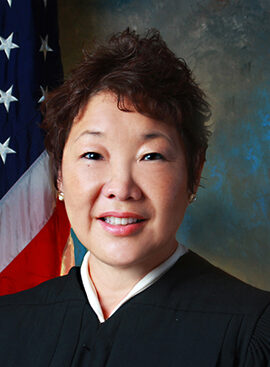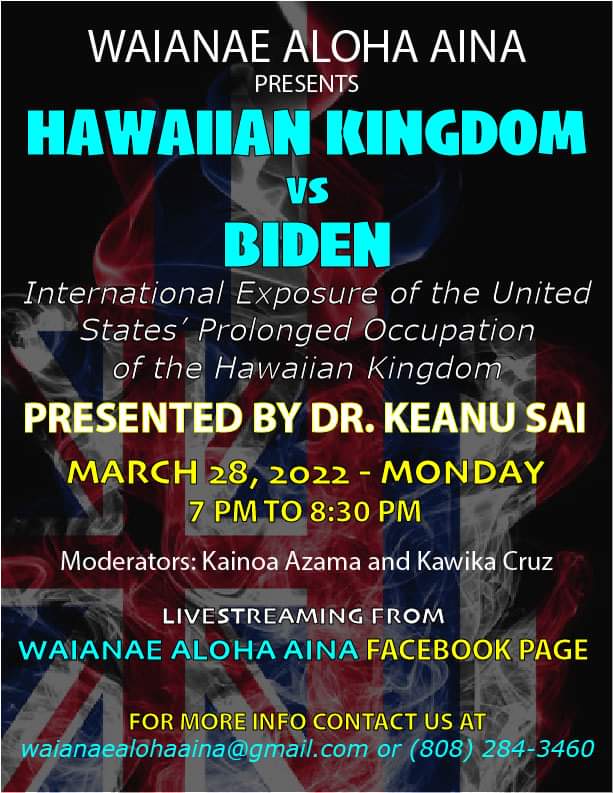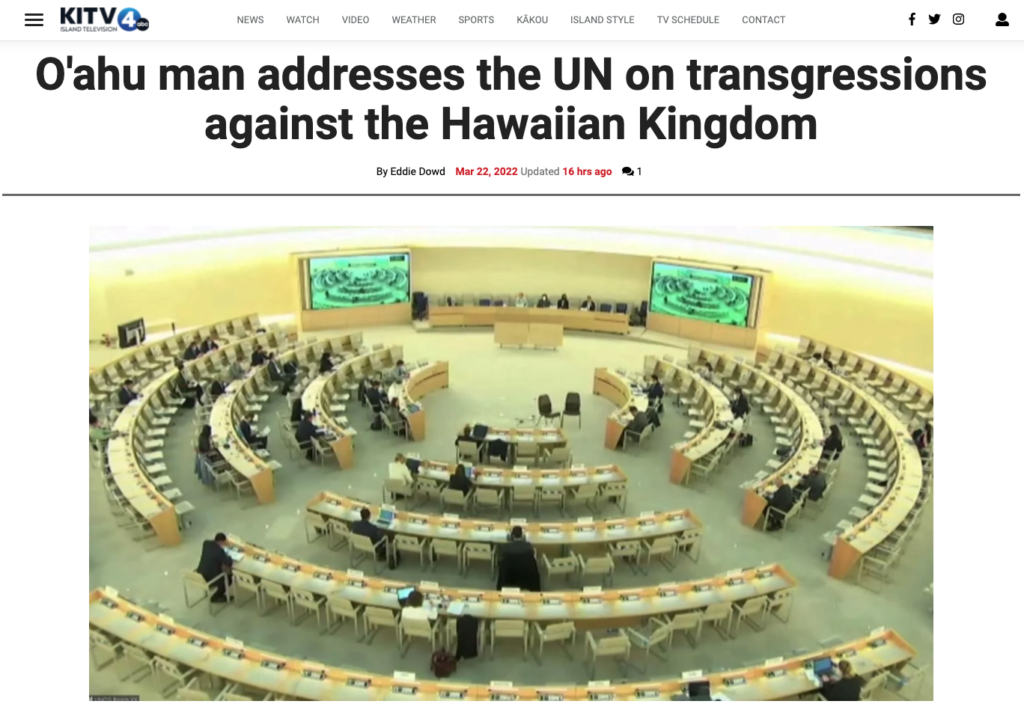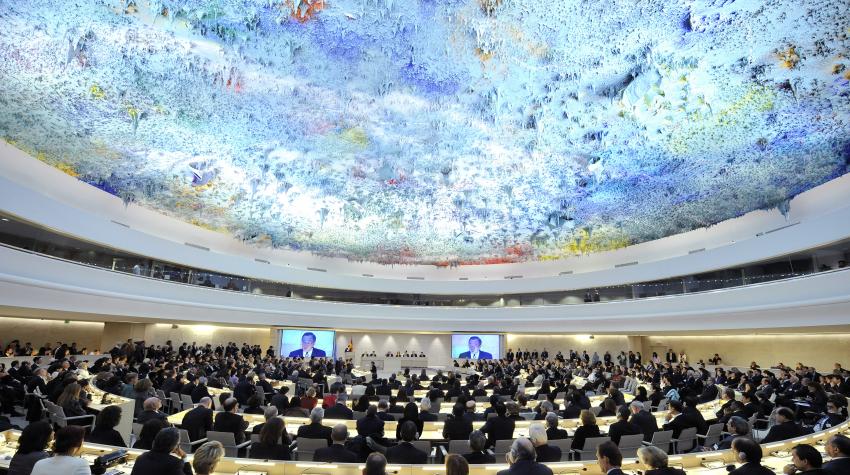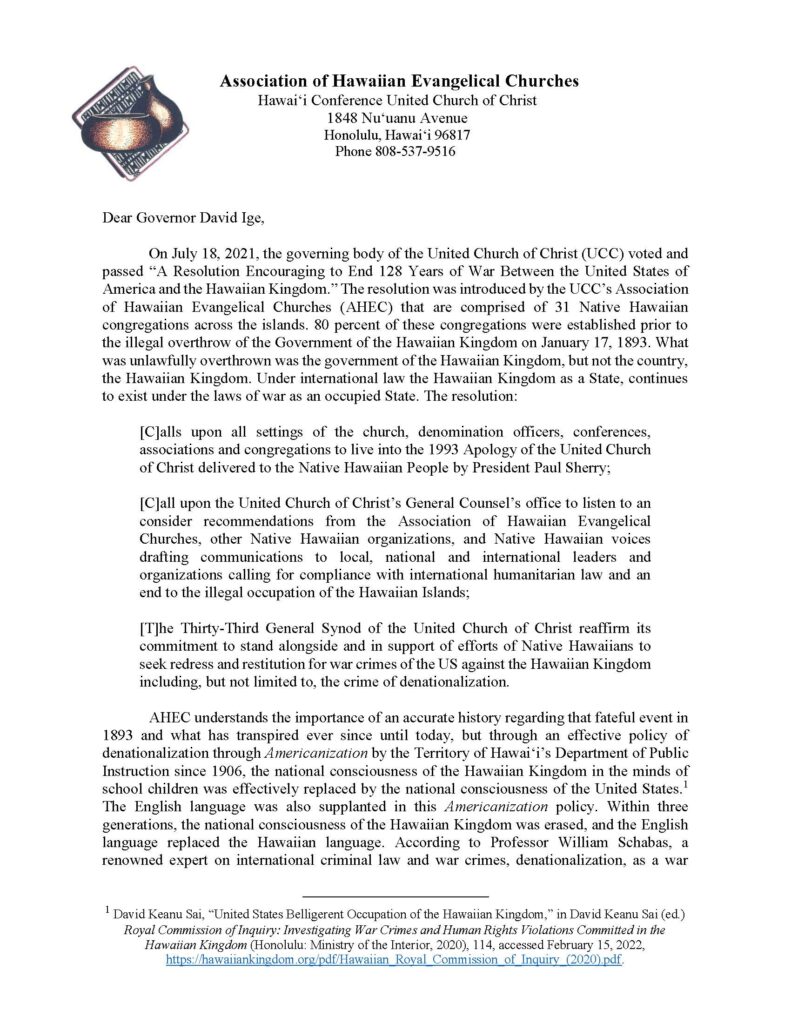The Hawaiian Kingdom v. Biden federal lawsuit is still playing out at the United States District Court for the District of Hawai‘i, despite the case also being heard by the Ninth Circuit Court of Appeals in San Francisco.
What is before the Ninth Circuit are not the two preliminary judgments made by Judge Leslie Kobayashi, but rather the lawful authority for Judge Kobayashi to make the judgments in the first place. The proceedings before the federal court in Honolulu was to get Judge Kobayashi to transform into an Article II Occupation Court so it would have lawful authority.
Right now, the federal court in Honolulu is operating as an Article III Court which is a part of the judiciary branch of government under article III of the United States Constitution. An Article II Occupation Court is a part of the executive branch of government under article II of the U.S. Constitution headed by the President as commander-in-chief of the armed forces.
Article II Occupation Courts are federal courts established in territory that is being occupied by the United States. Because Article III Courts operate within the territorial boundaries of the United States, they administer United States law. Article II Occupation Courts, on the other hand, administer the laws of the occupied State and the international law of occupation. Article II Occupation Courts were established in Germany after the defeat of the Nazi regime. These courts administered German law and the law of occupation.
Whenever defendants in Hawai‘i challenged the authority of the United States and the State of Hawai‘i in court, judges in State of Hawai‘i courts and in the federal court in Honolulu always referred to a 1994 State of Hawai‘i appeals case called State of Hawai‘i v. Lorenzo to quash the challenge. In that case, the Intermediate Court of Appeals (“Lorenzo Court”) stated:
Lorenzo appeals, arguing that the lower court erred in denying his pretrial motion (Motion) to dismiss the indictment. The essence of the Motion is that the [Hawaiian Kingdom] (Kingdom) was recognized as an independent sovereign nation by the United States in numerous bilateral treaties; the Kingdom was illegally overthrown in 1893 with the assistance of the United States; the Kingdom still exists as a sovereign nation; he is a citizen of the Kingdom; therefore, the courts of the State of Hawai‘i have no jurisdiction over him. Lorenzo makes the same argument on appeal. For the reasons set forth below, we conclude that the lower court correctly denied the Motion.
According to the Lorenzo Court it based its denial of the motion to dismiss because it “was incumbent on Defendant to present evidence supporting his claim. Lorenzo has presented no factual (or legal) basis for concluding that the Kingdom exists as a state in accordance with recognized attributes of a state’s sovereign nature.”
The Lorenzo Court’s standard of review in determining whether the Hawaiian Kingdom exists as a State placed the burden of proof on Lorenzo as the defendant. The Hawai‘i Supreme Court, in State of Hawai‘i v. Armitage, clarified this evidentiary burden. The Supreme Court stated:
Lorenzo held that, for jurisdictional purposes, should a defendant demonstrate a factual or legal basis that the [Hawaiian Kingdom] “exists as a state in accordance with recognized attributes of a state’s sovereign nature[,]” and that he or she is a citizen of that sovereign state, a defendant may be able to argue that the courts of the State of Hawai‘i lack jurisdiction over him or her.
Lorenzo became a precedent case on the subject of the Hawaiian Kingdom’s existence as a State in State of Hawai‘i courts, and is known in the United States District Court in Hawai‘i, since 2002, as the Lorenzo principle or doctrine. There have been seventeen federal cases that applied the Lorenzo doctrine, two of which came before the Ninth Circuit Court of Appeals in San Francisco.
The Lorenzo Court, however, did acknowledge that its “rationale is open to question in light of international law.” Whether or not the Hawaiian Kingdom “exists as a state in accordance with recognized attributes of a state’s sovereign nature,” international law is supposed to be applied. By placing the burden of proof on the defendant, the Lorenzo Court did not apply international law. Because international law provides for the presumption of the continuity of the State despite the overthrow of its government by another State, it shifts the burden of proof and what is to be proven.
According to Judge Crawford, there “is a presumption that the State continues to exist, with its rights and obligations…despite a period in which there is no, or no effective, government,” and belligerent occupation “does not affect the continuity of the State, even where there exists no government claiming to represent the occupied State.” “If one were to speak about a presumption of continuity,” explains Professor Craven, “one would suppose that an obligation would lie upon the party opposing that continuity to establish the facts substantiating its rebuttal. The continuity of the Hawaiian Kingdom, in other words, may be refuted only by reference to a valid demonstration of legal title, or sovereignty, on the part of the United States, absent of which the presumption remains.”
Evidence of “a valid demonstration of legal title, or sovereignty, on the part of the United States” would be an international treaty, particularly a peace treaty, whereby the Hawaiian Kingdom would have ceded its territory and sovereignty to the United States. Examples of foreign States ceding sovereign territory to the United States by a peace treaty include the 1848 Treaty of Peace, Friendship, Limits, and Settlement with the Republic of Mexico that ended the Mexican-American war, and the 1898 Treaty of Peace between the United States of America and the Kingdom of Spain that ended the Spanish-American War.
The 1898 Joint Resolution To provide for annexing the Hawaiian Islands to the United States, is a municipal law of the United States without extraterritorial effect. It is not an international treaty. Under international law, to annex territory of another State is a unilateral act, as opposed to cession, which is a bilateral act between States. Under international law, annexation of an occupied State is unlawful. According to The Handbook of Humanitarian Law in Armed Conflicts:
The international law of belligerent occupation must therefore be understood as meaning that the occupying power is not sovereign, but exercises provisional and temporary control over foreign territory. The legal situation of the territory can be altered only through a peace treaty or debellatio. International law does not permit annexation of territory of another state.
When the Lorenzo Court acknowledged that Lorenzo did state in his motion to dismiss the indictment that the Hawaiian Kingdom “was recognized as an independent sovereign nation by the United States in numerous bilateral treaties,” it set the presumption to be the Hawaiian Kingdom’s existence as a State under international law and not the existence of the State of Hawai‘i as a political subdivision of the United States. This would have resulted in placing the burden “on the party opposing that continuity to establish the facts substantiating its rebuttal.”
Under international law, it was not the burden of Lorenzo to provide evidence that the Hawaiian Kingdom “exists” when the Lorenzo Court already acknowledged its existence and recognition by the United States. Rather, it was the burden of the prosecution to provide evidence that the Hawaiian Kingdom “does not exist.” As a result, the Lorenzo Court’s ruling was wrong and all decisions that followed in State of Hawai‘i courts and Federal courts applying the Lorenzo doctrine also were wrong.
In Hawaiian Kingdom v. Biden, the United States filed a Motion to Dismiss the Hawaiian Kingdom’s Amended Complaint claiming that Hawai‘i was annexed by a joint resolution of Congress in 1898 and that Hawai‘i is the 50th State of the Union since 1959. Despite the frivolous claim by the United States that Hawai‘i was annexed by an American law, the Hawaiian Kingdom opposed the motion to dismiss because the Court has no authority to make any ruling until it transforms itself into an Article II Occupation Court. Article III Courts can only operate within the territory of the United States and not outside of it unless it is an Article II Occupation Court.
On June 9, 2022, Judge Kobayashi filed her Order granting the Federal Defendants’ motion to dismiss the Hawaiian Kingdom’s amended complaint claiming she doesn’t have to transform into an Article II Occupation Court because of the Lorenzo doctrine! Today the Hawaiian Kingdom filed its Motion to Amend or Alter the Order because Judge Kobayashi used the Lorenzo doctrine in error. In its Motion, the Hawaiian Kingdom concluded with:
Without citing any rebuttable evidence to the presumption of continuity of the Hawaiian State, the Court relied on Fonoti. This case, however, is not judge-made law or federal common law like Banco Nacional de Cuba v. Sabbatino regarding international relations. The Fonoti case was a decision that did not comply with the Lorenzo doctrine and, therefore, cannot be used by this Court as if it is federal common law. While the Court cited the Fonoti case in its granting of the Defendants’ cross-motion to dismiss, which was based on the Lorenzo doctrine, albeit in error, the Court willfully disregarded international law and the Lorenzo doctrine to the detriment of the Plaintiff Hawaiian Kingdom, being a manifest error of law and fact and a manifest injustice. The Court has willfully avoided the Lorenzo doctrine that calls for evidence that the Hawaiian Kingdom does not exist “as a state in accordance with recognized attributes of a state’s sovereign nature.” The Lorenzo doctrine does not seek to determine whether the government of the Hawaiian State exists. Notwithstanding the restoration of the government of the Hawaiian State three years after State of Hawai‘i v. Lorenzo in 1994 as a Council of Regency and Plaintiff in this case, the Lorenzo doctrine’s evidentiary burden was not altered except by the application of international law.
The Court has provided no legal basis to grant Defendants’ cross-motion to dismiss first amended complaint. Therefore, this Court is bound by treaty law to take affirmative steps to transform itself into an Article II Court by virtue of Article 43 of the 1907 Hague Regulations, just as the International Bureau of the PCA established the arbitral tribunal by virtue of Article 47 of the 1907 Hague Convention on the Pacific Settlement of International Disputes because of the juridical fact of the Hawaiian Kingdom’s existence as a State. This Court is also bound to transform itself into an Article II Court because it is situated within the territory of the Hawaiian Kingdom and not within the territory of the United States pursuant to the Lorenzo doctrine. Furthermore, Federal Defendants have provided no rebuttable evidence that the Hawaiian Kingdom as a State was extinguished under international law other than invoking its internal laws as justification for not complying with its international obligations, which are barred by customary international law and treaty law.
For 28 years the State of Hawai‘i courts and the U.S. federal court in Hawai‘i have been applying the Lorenzo doctrine, which they created, wrong. This is not a matter of reading the fine print in the Lorenzo Court’s decision. It was in plain view when the Lorenzo Court stated that “the court’s rationale is open to question in light of international law.”
As a federal judge, Judge Kobayashi is obligated to apply international law to the Lorenzo doctrine, because the U.S. Supreme Court, in the The Paquette Habana case, stated, “International law is part of our law, and must be ascertained and administered by the courts of justice of appropriate jurisdiction as often as questions of right depending upon it are duly presented for their determination.”

